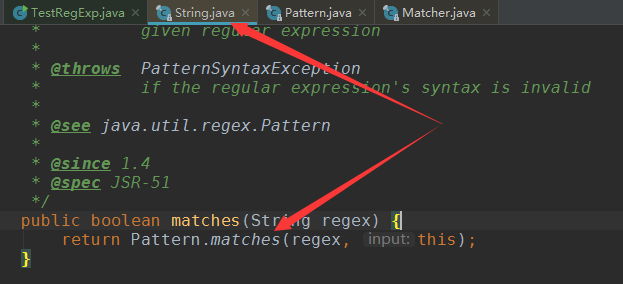1. Java中的正则表达式应用
1、java.util.regex 包主要包括以下三个类:
-
Pattern 类:
pattern 对象是一个正则表达式的编译表示。Pattern 类没有公共构造方法。要创建一个 Pattern 对象,你必须首先调用其公共静态编译方法,它返回一个 Pattern 对象。该方法接受一个正则表达式作为它的第一个参数。 -
Matcher 类:
Matcher 对象是对输入字符串进行解释和匹配操作的引擎。与Pattern 类一样,Matcher 也没有公共构造方法。你需要调用 Pattern 对象的 matcher 方法来获得一个 Matcher 对象。 -
PatternSyntaxException:
PatternSyntaxException 是一个非强制异常类,它表示一个正则表达式模式中的语法错误。
2. 下面介绍Pattern和Matcher 类中最常用的几个方法
1、Pattern类
Pattern类中有两个最常用的方法:
(1)boolean isMatch = Pattern.matches("regExp", "string");
matches()方法表示正则表达式regExp是否匹配字符串string,匹配返回true,不匹配返回false
注意:String类也有matches()方法,如"abcd".matches(regExp),其实他们俩是等价的,String类matches()方法就是调用的Pattern.matches()方法:
(2)Pattern pattern = Pattern.compile("regExp");
compile()方法表示编译此正则表达式regExp,返回regExp被编译后的pattern
如果只想知道该字符串是否匹配表达式,则直接使用matches()方法最简单
2、Matcher类
Matcher类没有提供什么静态方法,通过调用 Pattern 对象的 matcher 方法来获得一个 Matcher 对象,如
Pattern pattern = Pattern.compile("regExp");
Matcher matcher = pattern.matcher("string");
此时我们就得到了一个Matcher对象,通过此对象就可以对字符串进行操作了
Matcher类常用的方法:
(1)索引方法(精确表明输入字符串中在哪能找到匹配)
- public int start() 返回以前匹配的初始索引
- public int end() 返回最后匹配字符之后的偏移量。
(2)研究方法(用来检查输入字符串并返回一个布尔值,表示是否找到该模式)
- public boolean lookingAt() 尝试将从区域开头开始的输入序列与该模式匹配。
- public boolean find() 尝试查找与该模式匹配的输入序列的下一个子序列。
- public boolean matches() 尝试将整个区域与模式匹配。
(3)替换方法(替换输入字符串里文本的方法)
- public String replaceAll(String replacement) 替换模式与给定替换字符串相匹配的输入序列的每个子序列。
- public String replaceFirst(String replacement) 替换模式与给定替换字符串匹配的输入序列的第一个子序列。
3. 实例
1、start 和 end 方法
下面是一个对单词 "cat" 出现在输入字符串中出现次数进行计数的例子:
import java.util.regex.Matcher;
import java.util.regex.Pattern;
public class RegexMatches
{
private static final String REGEX = "\bcat\b";
private static final String INPUT =
"cat cat cat cattie cat";
public static void main( String args[] ){
Pattern p = Pattern.compile(REGEX);
Matcher m = p.matcher(INPUT); // 获取 matcher 对象
int count = 0;
while(m.find()) {
count++;
System.out.println("Match number "+count);
System.out.println("start(): "+m.start());
System.out.println("end(): "+m.end());
}
}
}
运行结果:
Match number 1
start(): 0
end(): 3
Match number 2
start(): 4
end(): 7
Match number 3
start(): 8
end(): 11
Match number 4
start(): 19
end(): 22
2、matches 和 lookingAt 方法
matches 和 lookingAt 方法都用来尝试匹配一个输入序列模式。它们的不同是 matches 要求整个序列都匹配,而lookingAt 不要求。
import java.util.regex.Matcher;
import java.util.regex.Pattern;
public class RegexMatches
{
private static final String REGEX = "foo";
private static final String INPUT = "fooooooooooooooooo";
private static final String INPUT2 = "ooooofoooooooooooo";
private static Pattern pattern;
private static Matcher matcher;
private static Matcher matcher2;
public static void main( String args[] ){
pattern = Pattern.compile(REGEX);
matcher = pattern.matcher(INPUT);
matcher2 = pattern.matcher(INPUT2);
System.out.println("Current REGEX is: "+REGEX);
System.out.println("Current INPUT is: "+INPUT);
System.out.println("Current INPUT2 is: "+INPUT2);
System.out.println("lookingAt(): "+matcher.lookingAt());
System.out.println("matches(): "+matcher.matches());
System.out.println("lookingAt(): "+matcher2.lookingAt());
}
}
运行结果:
Current REGEX is: foo
Current INPUT is: fooooooooooooooooo
Current INPUT2 is: ooooofoooooooooooo
lookingAt(): true
matches(): false
lookingAt(): false
3、replaceFirst 和 replaceAll 方法
replaceFirst 和 replaceAll 方法用来替换匹配正则表达式的文本。不同的是,replaceFirst 替换首次匹配,replaceAll 替换所有匹配。
import java.util.regex.Matcher;
import java.util.regex.Pattern;
public class RegexMatches
{
private static String REGEX = "dog";
private static String INPUT = "The dog says meow. " +
"All dogs say meow.";
private static String REPLACE = "cat";
public static void main(String[] args) {
Pattern p = Pattern.compile(REGEX);
// get a matcher object
Matcher m = p.matcher(INPUT);
INPUT = m.replaceAll(REPLACE);
System.out.println(INPUT);
}
}
运行结果:
The cat says meow. All cats say meow.
